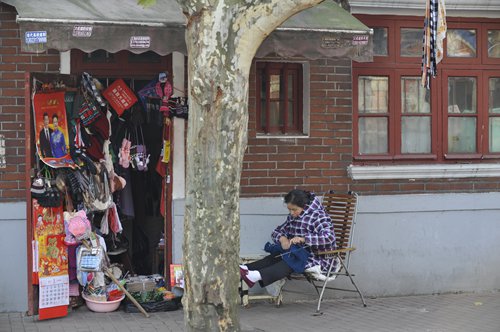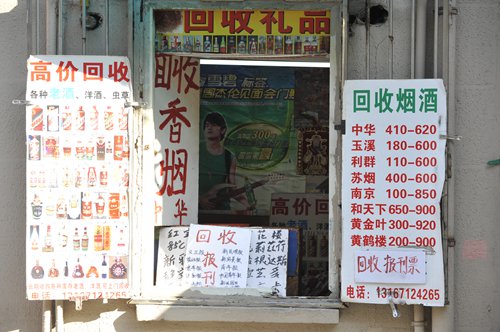
A woman knits in front of her sundries supply stall. (Photo/GT)

Window vendor advertising reclaimed alcohol and tobacco products (Photo/GT)
As big businesses buy up Shanghai, local vendors peddle wares out of homes
This past year, swaths of older neighborhoods in northeastern Jing'an district were wiped off the map in order to make way for commercial developments. The same with the former Zhabei district, where many traditional tenements have been leveled as the municipality prepares for yet another wave of its unending modernization campaign. Along with the displaced households, hundreds of family-run shops were also forced to close their doors. In other parts of the city where urban upscaling looms, many mom-and-pop vendors are giving up their awning'd storefronts to sell goods out of their homes.
Under Shanghai's old lilong (lane housing) model, there was at least one dedicated shopping street per residential quarter where locals could obtain everyday necessities - wet market, sundries stores, a variety of repairmen, noodle and snack stalls, barbers and massages, clothing boutiques, alcohol and tobacco dealers - without having to go beyond their own community.
But hyper-commercialization coupled with eye-watering real estate prices have steadily driven out the small-scale retail shops that were once pillars of Shanghai neighborhoods.
A patchwork of old residential corridors between Shimen'er Road and Jiangning Road were, in 2016, forever erased, whereas some traditional enclaves of Beizhan subdistrict have resiliently withstood this planned urban transformation.
Luxury compounds, steel-and-glass office towers and corporate-owned chains are steadily buying up downtown Shanghai as demographics shift to the affluent. And while many mom-and-pop retail tenants can no longer afford their leases, some nonetheless refuse to give up their generations-old trade.
A stroll along Shanhaiguan Road East, Wufu Alley or Xizang Road North reveals residential homes whose street-side, ground-floor windows and doors have been converted into storefronts.
With no marquee, these secret, speakeasy-style shops are known only by, and cater only to, their immediate neighbors. Yet they are the literal face of their communities, contributing more to neighborhood dynamics and Shanghai's local identity than gentrification and generic commercialization ever can.
They might not be around much longer - once their wood-and-brick homes go, so too will they - but until then we must admire their entrepreneurial perseverance.


















































